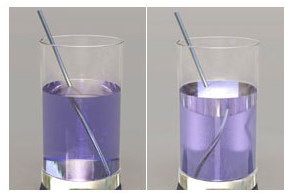Metamaterials or what opportunities await us in the future
Yes, the pace of technological development is known to everyone, so it becomes possible to translate the theory of past years into reality. If earlier, some statements could make society laugh, as they once did not believe Pythagoras that the Earth has a round shape, so at the beginning of the 20th century - the proof of the possibility of a negative refractive index did not convince scientists.
 Really how?
Really how?
And after several decades, when the first time it was possible to achieve a negative refractive index, the theory surfaced again and in a different course.
Actually, what I would like to talk about is based on the theory of metamaterials.
Metamaterial is an artificial substance that can interact with electromagnetic waves in a way that natural materials cannot. The prefix "meta" in this case emphasizes that these composite materials as a whole have electromagnetic properties that are not inherent in any of the constituent elements.
Metamaterials have a negative refractive index. This effect is achieved due to the simultaneous change in the dielectric and magnetic permeability of the substance, the main characteristics of the field, describing the propagation of electromagnetic waves in the medium. This means that when a ray of light passes from one medium to another, the refracted ray will fall not into the “right” medium, but into the “left” one relative to the perpendicular drawn from the point of incidence of the ray.

In media with a negative refractive index, the inverse Doppler effect and the Vavilov-Cherenkov effect will be observed, i.e. phase velocity reversal occurs .
In the first case, the light source (radiation) is to the left of the video
In the second case, on the right
Also, the optical properties inherent in scattering and collective lenses change relative to each other due to the negative refractive index.
Astronomy and radiophysics : coatings made of metamaterials work just fine to protect objects from sensors or telescopes using long-wave radiation rather than visible light.
Optics: the absence of a diffraction limit for lenses needs no comment.
Microelectronics: the emergence of smaller and at the same time more efficient antennas and devices for cell phones, the expansion of the density of data storage on disks and more complex electronic circuits.
Development of more powerful lasers: the development of more powerful lasers that, at the same pump energy, produce several times more powerful and destructive light pulses.
New anti-glare materials;
And what’s the most interesting, the development and implementation of this theory will allow in a certain frequency range to hide objects from radars / sensors.
Now it is achieved in the terahertz frequency range. And tomorrow - you look, and in the "visible" it will turn out.
 Really how?
Really how? And after several decades, when the first time it was possible to achieve a negative refractive index, the theory surfaced again and in a different course.
Actually, what I would like to talk about is based on the theory of metamaterials.
Metamaterial is an artificial substance that can interact with electromagnetic waves in a way that natural materials cannot. The prefix "meta" in this case emphasizes that these composite materials as a whole have electromagnetic properties that are not inherent in any of the constituent elements.
Metamaterials have a negative refractive index. This effect is achieved due to the simultaneous change in the dielectric and magnetic permeability of the substance, the main characteristics of the field, describing the propagation of electromagnetic waves in the medium. This means that when a ray of light passes from one medium to another, the refracted ray will fall not into the “right” medium, but into the “left” one relative to the perpendicular drawn from the point of incidence of the ray.

In media with a negative refractive index, the inverse Doppler effect and the Vavilov-Cherenkov effect will be observed, i.e. phase velocity reversal occurs .
In the first case, the light source (radiation) is to the left of the video
In the second case, on the right
Also, the optical properties inherent in scattering and collective lenses change relative to each other due to the negative refractive index.
What does all this give:
Astronomy and radiophysics : coatings made of metamaterials work just fine to protect objects from sensors or telescopes using long-wave radiation rather than visible light.
Optics: the absence of a diffraction limit for lenses needs no comment.
Microelectronics: the emergence of smaller and at the same time more efficient antennas and devices for cell phones, the expansion of the density of data storage on disks and more complex electronic circuits.
Development of more powerful lasers: the development of more powerful lasers that, at the same pump energy, produce several times more powerful and destructive light pulses.
New anti-glare materials;
And what’s the most interesting, the development and implementation of this theory will allow in a certain frequency range to hide objects from radars / sensors.
Now it is achieved in the terahertz frequency range. And tomorrow - you look, and in the "visible" it will turn out.
